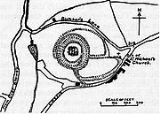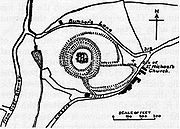
Stowey Castle
Encyclopedia
Stowey Castle was a Norman
motte-and-bailey
castle, built in the 11th century, in the village of Nether Stowey
on the Quantock Hills
in Somerset
, England. It has been designated as a Scheduled Ancient Monument
.
 The Castle is sited on a small isolated knoll of Leighland Slates of the Devonian
The Castle is sited on a small isolated knoll of Leighland Slates of the Devonian
series, about 390 feet (119 m) high. It consisted of a square keep, (which may have been stone, or a wooden superstructure on stone foundations) and its defences, and an outer and an inner bailey. The mount is 29 feet (9 m) above the 6 feet (2 m) wide ditch which itself is 7 feet (2 m) deep. The motte has a flat top with two large and two small mounds as the edge which may be sites of towers. Central area occupied by approximately square foundations 33 feet (10 m) by 33 feet (10 m) with internal divisions.
The blue lias
rubble walling is the only visible structural remains of the castle which stand on a conical earthwork with a ditch approximately 820 feet (250 m) in circumference.
The castle was destroyed in the 15th century, which may have been as a penalty for the local Lord Audley
's involvement in the Second Cornish Uprising of 1497
led by Perkin Warbeck
. Some of the stone was used in the building of Stowey Court in the village.
Normans
The Normans were the people who gave their name to Normandy, a region in northern France. They were descended from Norse Viking conquerors of the territory and the native population of Frankish and Gallo-Roman stock...
motte-and-bailey
Motte-and-bailey
A motte-and-bailey is a form of castle, with a wooden or stone keep situated on a raised earthwork called a motte, accompanied by an enclosed courtyard, or bailey, surrounded by a protective ditch and palisade...
castle, built in the 11th century, in the village of Nether Stowey
Nether Stowey
Nether Stowey is a large village in the Sedgemoor district of Somerset, South West England. It sits in the foothills of the Quantock Hills , just below Over Stowey...
on the Quantock Hills
Quantock Hills
The Quantock Hills is a range of hills west of Bridgwater in Somerset, England. The Quantock Hills were England’s first Area of Outstanding Natural Beauty being designated in 1956 and consists of large amounts of heathland, oak woodlands, ancient parklands and agricultural land.The hills run from...
in Somerset
Somerset
The ceremonial and non-metropolitan county of Somerset in South West England borders Bristol and Gloucestershire to the north, Wiltshire to the east, Dorset to the south-east, and Devon to the south-west. It is partly bounded to the north and west by the Bristol Channel and the estuary of the...
, England. It has been designated as a Scheduled Ancient Monument
Scheduled Ancient Monument
In the United Kingdom, a scheduled monument is a 'nationally important' archaeological site or historic building, given protection against unauthorized change. The various pieces of legislation used for legally protecting heritage assets from damage and destruction are grouped under the term...
.
Details

Devonian
The Devonian is a geologic period and system of the Paleozoic Era spanning from the end of the Silurian Period, about 416.0 ± 2.8 Mya , to the beginning of the Carboniferous Period, about 359.2 ± 2.5 Mya...
series, about 390 feet (119 m) high. It consisted of a square keep, (which may have been stone, or a wooden superstructure on stone foundations) and its defences, and an outer and an inner bailey. The mount is 29 feet (9 m) above the 6 feet (2 m) wide ditch which itself is 7 feet (2 m) deep. The motte has a flat top with two large and two small mounds as the edge which may be sites of towers. Central area occupied by approximately square foundations 33 feet (10 m) by 33 feet (10 m) with internal divisions.
The blue lias
Lias Group
The Lias Group or Lias is a lithostratigraphic unit found in a large area of western Europe, including the British Isles, the North Sea, the low countries and the north of Germany...
rubble walling is the only visible structural remains of the castle which stand on a conical earthwork with a ditch approximately 820 feet (250 m) in circumference.
The castle was destroyed in the 15th century, which may have been as a penalty for the local Lord Audley
James Tuchet, 7th Baron Audley
Sir James Tuchet, 7th Baron Audley was born in the Heleigh Castle, Staffordshire, England to John Tuchet, 6th Baron Audley and Ann Echingham....
's involvement in the Second Cornish Uprising of 1497
Second Cornish Uprising of 1497
The Second Cornish Uprising is the name given to the Cornish uprising of September 1497 when the pretender to the throne Perkin Warbeck landed at Whitesand Bay, near Land's End, on 7 September with just 120 men in two ships...
led by Perkin Warbeck
Perkin Warbeck
Perkin Warbeck was a pretender to the English throne during the reign of King Henry VII of England. By claiming to be Richard of Shrewsbury, Duke of York, the younger son of King Edward IV, one of the Princes in the Tower, Warbeck was a significant threat to the newly established Tudor Dynasty,...
. Some of the stone was used in the building of Stowey Court in the village.

